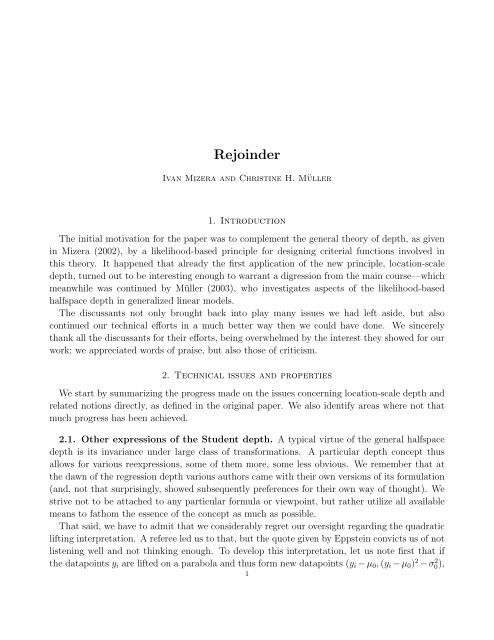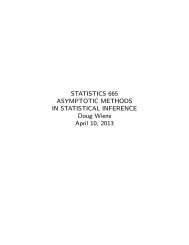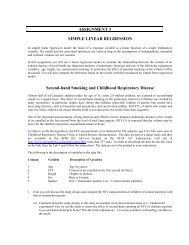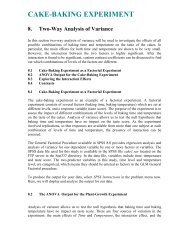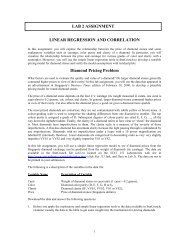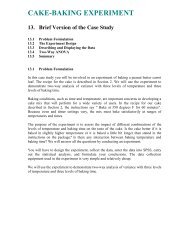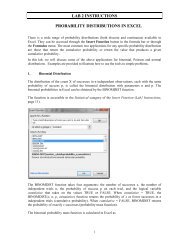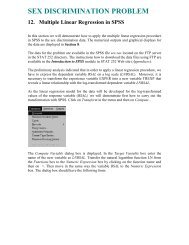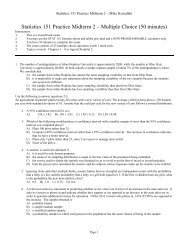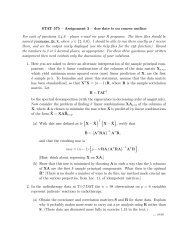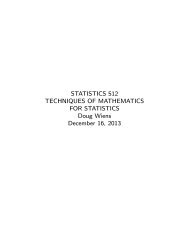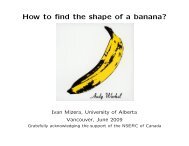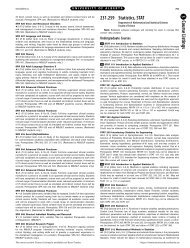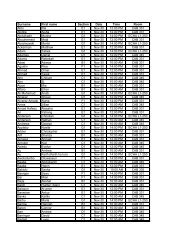Rejoinder
Rejoinder
Rejoinder
Create successful ePaper yourself
Turn your PDF publications into a flip-book with our unique Google optimized e-Paper software.
<strong>Rejoinder</strong><br />
Ivan Mizera and Christine H. Müller<br />
1. Introduction<br />
The initial motivation for the paper was to complement the general theory of depth, as given<br />
in Mizera (2002), by a likelihood-based principle for designing criterial functions involved in<br />
this theory. It happened that already the first application of the new principle, location-scale<br />
depth, turned out to be interesting enough to warrant a digression from the main course—which<br />
meanwhile was continued by Müller (2003), who investigates aspects of the likelihood-based<br />
halfspace depth in generalized linear models.<br />
The discussants not only brought back into play many issues we had left aside, but also<br />
continued our technical efforts in a much better way then we could have done. We sincerely<br />
thank all the discussants for their efforts, being overwhelmed by the interest they showed for our<br />
work; we appreciated words of praise, but also those of criticism.<br />
2. Technical issues and properties<br />
We start by summarizing the progress made on the issues concerning location-scale depth and<br />
related notions directly, as defined in the original paper. We also identify areas where not that<br />
much progress has been achieved.<br />
2.1. Other expressions of the Student depth. A typical virtue of the general halfspace<br />
depth is its invariance under large class of transformations. A particular depth concept thus<br />
allows for various reexpressions, some of them more, some less obvious. We remember that at<br />
the dawn of the regression depth various authors came with their own versions of its formulation<br />
(and, not that surprisingly, showed subsequently preferences for their own way of thought). We<br />
strive not to be attached to any particular formula or viewpoint, but rather utilize all available<br />
means to fathom the essence of the concept as much as possible.<br />
That said, we have to admit that we considerably regret our oversight regarding the quadratic<br />
lifting interpretation. A referee led us to that, but the quote given by Eppstein convicts us of not<br />
listening well and not thinking enough. To develop this interpretation, let us note first that if<br />
the datapoints y i are lifted on a parabola and thus form new datapoints (y i − µ 0 , (y i − µ 0 ) 2 − σ 2 0),<br />
1
then the halfspace (Tukey) depth of a plane point (µ, σ) is equal to the depth of the transformed<br />
point<br />
( ( ) ( ) ( 1 0 µ −µ 0<br />
+<br />
−2µ 1)<br />
σ 2µ 2 =<br />
− σ 0)<br />
with respect to the transformed datapoints<br />
( ) (<br />
) ( ) (<br />
)<br />
1 0 y i − µ 0<br />
−µ<br />
y<br />
−2µ 1 (y i − µ 0 ) 2 − σ0<br />
2 +<br />
2µ 2 =<br />
i − µ 0 − µ<br />
− σ (y i − µ 0 − µ) 2 − (σ0 2 − µ 2 ,<br />
+ σ),<br />
thanks to the affine invariance of the halfspace depth. That is, the halfspace depth of (µ, σ) is<br />
equal to the Student depth of (µ + µ 0 , √ σ − µ 2 + σ0). 2 Setting µ 0 = 0, σ 0 = 0 gives the brilliant<br />
observation of Eppstein: the Tukey depth of (µ, σ) with respect to the lifted observations (y i , yi 2 )<br />
is the Student depth of (µ, √ σ − µ 2 ). Apparently, we have to require that (µ, σ) lies inside the<br />
parabola—but the depth would be otherwise 0 anyway.<br />
If we set (µ 0 , σ 0 ) to be a Student median (µ S , σ S ), we obtain another lucid characterization:<br />
(µ S , σ S ) are precisely those parameters for which (0, 0) is a Tukey median of the lifted datapoints<br />
(y i − µ S , (y i − µ S ) 2 − σS 2 ). This characterization emerged simultaneously in the discussion of<br />
Hubert, Rousseeuw, and Vanden Branden, and in that of Serfling. To see why it is true, note<br />
that the Student depth of (µ S , σ S ) must be positive, due to the centerpoint theorem; and it is<br />
equal to the halfspace depth of (0, 0) with respect to the lifted datapoints (y i −µ S , (y i −µ S ) 2 −σS 2).<br />
To verify that (0, 0) is a Tukey median of the lifted datapoints, one only has to show that the<br />
Tukey depth of no point (µ, σ) in the plane is larger than the halfspace depth of (0, 0). But this<br />
is indeed true, since either (σ − µ 2 + σS 2 ) < 0 and then the Tukey depth of (µ, σ) is zero, or it is<br />
equal to the Student depth of (µ 0 + µ, √ σ − µ 2 + σS 2 ), which cannot be larger than the Student<br />
depth of (µ S , σ S ).<br />
2.2. Other instances of the location-scale depth. An intriguing question, reiterated by<br />
Eppstein, is whether similar manipulations could not show that the location-scale depth for<br />
certain alternative likelihoods is not merely a rescaling of the Student depth. Let us remark that<br />
the positive answer would not change that much from the data-analytic point of view; the Student<br />
depth will still be the most appealing alternative from the conceptual and computational point of<br />
view . From the philosophical aspect, however, the positive answer could considerably underscore<br />
the nonparametric character of the location-scale depth. Our original Figure 2 suggests that the<br />
answer might be positive for the logistic likelihood, but negative for the slash.<br />
We were not able to make any further progress on this problem; but let us at least note<br />
the following. The success of the parabolic lifting manipulations crucially depended on the<br />
following property of the Student depth: there are linear transformations capable of transforming<br />
a parabola to another parabola. It does not seem that other functions from our original Figure 1<br />
enjoy this favorable property. In this context, we would like to raise a cautionary remark. While<br />
the equation (3) of Hubert, Rousseeuw, and Vanden Branden indeed characterizes the Student<br />
median, as shown above, we are not sure whether their more general formula (4), or the general<br />
2
formula (3) of Serfling characterizes the maximum location-scale depth also when ψ(τ) is not<br />
equal to τ and χ(τ) to τ 2 − 1; that is, for other than the Student version of location-scale depth.<br />
(At least, we were not able to furnish an adequately general proof.) Of course, the validity of<br />
the characterization for more general ψ and χ does not change anything on the fact that the<br />
aforementioned formulas represents viable estimating proposals of their own.<br />
2.3. The role of hyperbolic geometry and its models. We perceive hyperbolic geometry<br />
and its models as an important vehicle to gain more insight into the nature of the topic—and<br />
hope that it will help the reader in a similar way. However, it seems that sometimes this effort<br />
is not completely understood. Occasionally, we can observe a certain kind of fundamentalism<br />
which takes pride in “eliminating” this or that particular model or some other mathematical<br />
component. We do not subscribe to this attitude: a standardized lowbrow pedagogical approach<br />
is not our objective, we rather endorse diversity aimed at wide understanding.<br />
There is nothing special about any model of hyperbolic geometry. In particular, we would<br />
like to stress than none of our definitions depends on the Klein disk KD or any other model of<br />
hyperbolic geometry. From the formal point of view, whether we do or do not transform to KD<br />
or any other model is entirely inessential.<br />
For instance, when defining the location-scale simplicial depth, we think about a triangle<br />
formed by three datapoints y i1 ≤ y i2 ≤ y i3 . Caution: it is not a usual Euclidean triangle, but a<br />
hyperbolic triangle; that is, in the Poincaré halfspace model (µ, σ) lies inside this triangle if an<br />
only if either y i1 ≤ µ ≤ y i2 and (µ − y i1 )(y i2 − µ) ≤ σ 2 ≤ (µ − y i1 )(y i3 − µ) or y i2 ≤ µ ≤ y i3 and<br />
(µ−y i2 )(y i3 −µ) ≤ σ 2 ≤ (µ−y i1 )(y i3 −µ). These formulas are somewhat awkward (although their<br />
message is clear as soon as a picture is made; see our original Figure 6), hence one may prefer<br />
the Klein disk or Eppstein’s parabolic lifting model instead, where the appropriately transformed<br />
(µ, σ) lies inside the hyperbolic triangle formed by appropriately transformed datapoints if and<br />
only if it lies inside the triangle formed by them in the usual Euclidean sense. However, the<br />
definition of the triangle, and subsequently of the simplicial depth, does not depend on those<br />
particular models; one may enjoy only the convenience that hyperbolic triangles in certain models<br />
look like the Euclidean ones.<br />
Another instance is computation. The Student depth can be calculated via reusing of an<br />
algorithm for the bivariate location (Tukey) depth—this needs a transformation to the Klein<br />
disk, or, even better, parabolic lifting. Or, it can be computed directly in the Poincaré plane, in<br />
the vein of Theorems 8 and 9.<br />
2.4. The Student median. So far, probably the least understood issue from theoretical<br />
point of view is the relationship between the Student median location and scale pair and the<br />
sample median/MAD. He and Portnoy tried to shed some light on the question posed by Serfling:<br />
“in what way does the Student median take us beyond just using the median and MAD?”. Their<br />
experimental observations essentially agree with ours. Generally, the Student median and the<br />
median/MAD differ; however, the difference is much smaller than our rather crude (but the only<br />
3
one rigorous available) bound in Theorem 6 would indicate. The only other formal observation is<br />
that for samples from symmetric distributions we expect the location part of the Student median<br />
to be close to the sample median, since both consistently estimate the center of symmetry.<br />
The situation somewhat resembles the celebrated mean-median-mode relationship; perhaps<br />
this is another situation whose rigorous analysis is possible only in certain special setting. Let<br />
us repeat again that the examples observed so far indicate that the Student median might be a<br />
“shrunk” version of the median/MAD, shrunk toward something that perhaps could be called<br />
very vaguely a modal area, the area of concentration.<br />
Fortunately, the perspectives on other theoretic fronts are much more optimistic. A penetrating<br />
analysis of Hubert, Rousseeuw, and Vanden Branden not only nicely rounded the knowledge<br />
about breakdown value of the Student median—by showing that our lower bound of 1/3 is<br />
actually the upper one as well—but they scored a real breakthrough in deriving the influence<br />
function of the Student median (answering, at least partially, another Serfling’s question).<br />
This rigorous derivation, backed up by computational evidence, is not that exciting because<br />
of its existence (foreseen already in our original paper), but mainly because of its implication:<br />
the influence function of the Student median at the Cauchy model coincides with that of the<br />
Cauchy location-scale maximum likelihood estimator. Since we already knew that under the<br />
Cauchy model, the two estimators are o p (1) asymptotically equivalent, and that they are exactly<br />
equal for sample sizes n = 3, 4, an intriguing question arises: could the asymptotic equivalence<br />
be o P (n −1/2 )?<br />
To gain some more insight, we decided to continue the simulation study of He and Portnoy.<br />
In addition to their distributions, we added t with degrees of freedom 5 and 1 (the Cauchy<br />
distribution), motivated by the fact that their repertory does not contain any really heavy-tailed<br />
distribution. We took 1000 replications at sample sizes n = 10, 30, 100, and 1000, and computed<br />
the sample variances of the resulting Student median location and scale; of the sample median<br />
and MAD; and of the location-scale Cauchy maximum likelihood estimates. The results are<br />
summarized, separately for location and scale, in Tables 1 and 2.<br />
Table 1 shows that for the Gaussian and Laplace distributions, the Student median is often<br />
the worst and the sample median almost often the best—but the efficiency loss is never dramatic.<br />
For the 75:25 Gaussian mixture and the t with 5 degrees of freedom, all estimators perform about<br />
equally well. The Cauchy MLE is the best for the samples from the Cauchy distribution; but<br />
note that the Student median dominates the sample median in this case.<br />
For other asymmetric distributions in the study, the Student median is almost always the<br />
best and the sample median the worst, with the difference being considerably larger than for<br />
the symmetric distributions. The exceptions are the exponential and beta for the sample size<br />
n = 10.<br />
For symmetric bimodal distributions, we observe even more significant differences. For the<br />
beta(.2,.2), the sample median clearly outperforms both the Student median and the Cauchy<br />
4
5<br />
n ˆµ N(0,1) Lap. Exp. Γ(.2) β(.2,1) β(.2,.2) 75:25 .5:.5 t(5) t(1)<br />
sml 166067 173832 108365 2233 5643 131172 233978 4291033 195032 293211<br />
10 med 141617 150476 93348 3464 6083 86592 236520 4328369 167138 310547<br />
cml 165446 157859 98347 1811 4625 130702 232649 5728214 189879 267392<br />
sml 58516 43288 30226 140 442 86824 78335 1599945 62082 83772<br />
30 med 54057 40630 34292 532 1278 50361 76423 3223681 59265 95327<br />
cml 58862 39939 31238 148 547 83357 74216 4031367 60449 79853<br />
sml 16893 11669 8939 17 58 44697 23471 483633 17084 20020<br />
100 med 16168 10986 10385 144 319 19762 23785 2223249 18010 24866<br />
cml 17707 11115 9438 30 89 39100 22896 2298418 17756 19982<br />
sml 1597 1237 815 1 3 6284 2149 62458 1873 2018<br />
1000 med 1557 1081 1041 12 25 2297 1968 1027344 1858 2565<br />
cml 1672 1235 913 2 5 5163 2079 507306 1899 1981<br />
Table 1. Estimated variance (×10 6 ) of the location part of the Student median<br />
(sml), the sample median (med), and the location part of location-scale Cauchy<br />
MLE (cml), for sample sizes n = 10, 30, 100, 1000.<br />
MLE. On the other hand, for the .5:.5 Gaussian mixture, the estimated variance of the Student<br />
median is much smaller than that of the sample median and Cauchy MLE.<br />
For these distributions, He and Portnoy raise the question of the asymptotic independence<br />
and “quadratic” relationship between ˆµ and ˆσ. They assert that for symmetric distributions,<br />
ˆµ and ˆσ “should be rather independent (at least asymptotically)”. This may be based on the<br />
remark in the last paragraph of Section 6.4 in Huber (1981), which on asymptotic grounds<br />
addresses the simultaneous M-estimators of location and scale—and can be generalized to all<br />
regular situations when the asymptotic variance matrix can be found via formulas involving<br />
similarly behaving influence functions.<br />
Figure 1 shows, however, that such asymptotics should be interpreted with some care. The<br />
panels show the values of the sample median and MAD, together with the values of the Student<br />
median, for simulated samples from the beta(.2,.2) and .5:.5 Gaussian mixture. The sample median/MAD<br />
pair falls under the case originally addressed by Huber; their asymptotic distribution<br />
is indeed Gaussian, with the diagonal variance matrix. Nevertheless, we clearly observe—in particular<br />
in the left panel—that the dependence pattern is even stronger than that for the Student<br />
median.<br />
A bimodal situation like this is a trap for estimators with breakdown value 1/2. They behave<br />
like Buridan’s Ass between two haystacks 1 : if purely deterministic, it would be starved to death<br />
by its inability to choose among equally attractive alternatives. Stochastics saves the donkey—<br />
but in repeated trials, both haystacks are visited about equally often. In technical terms, the<br />
1 See, for instance, Blackburn, S.: The Oxford Dictionary of Philosophy, Oxford University Press, Oxford, 1996.
6<br />
beta(.2,.2)<br />
.5 N(−3,1) + .5 N(3,1)<br />
σ<br />
0.1 0.2 0.3 0.4 0.5<br />
σ<br />
1.5 2.0 2.5 3.0 3.5<br />
0.0 0.2 0.4 0.6 0.8 1.0<br />
µ<br />
−3 −2 −1 0 1 2 3<br />
µ<br />
Figure 1. Median and MAD (•) and the Student median (+) from 100 samples<br />
of size n = 100, drawn from the beta(.2,.2) distribution and .5:.5 random Gaussian<br />
mixture.<br />
result may be inconsistency, as demonstrated by Freedman and Diaconis (1982) for M-estimators<br />
minimizing a non-convex function; see also Mizera (1994). Neither Student median with its<br />
breakdown value 1/3, nor the sample median as an M-estimator minimizing a convex function<br />
are formally covered by this theory; but even though they are both consistent, this phenomenon<br />
results in inflated asymptotic variance.<br />
Recall that the asymptotic variance of the sample median is inversely proportional to the<br />
value of the density of the sampling distribution at the median. The density of beta(.2,.2) is<br />
well beyond 0 at 0, hence the sample median performs well in this case. However, the value of<br />
the density of the .5:.5 Gaussian mixture at 0 (three standard deviations from both means) is<br />
very small. Note that in the last case, the Cauchy MLE, whose breakdown value is 1/2, does<br />
not perform well either; only the Student median shows definite convergence (confirmed also by<br />
larger sample sizes not shown here).<br />
In the spirit of Theorem 4.1 of Mizera (2002), which says that bias sets are contained in deep<br />
depth contours, a possible explanation could be that the simulated values of the Student median<br />
tend to follow the shape of deeper contours—which in bimodal cases indeed have the crescentlike,<br />
bent down form. Note also that it is hard to tell the quadratic fit from that by a circle arc<br />
in the scale of a data cloud corresponding to n = 10000.<br />
Table 2 shows that the behavior of the Student median scale is considerably simpler. The<br />
MAD is always significantly worst, except for the sample size n = 10 from the .5:.5 Gaussian<br />
mixture and the Cauchy distribution. The Student median scale is always either the best, or
7<br />
n ˆσ N(0,1) Lap. Exp. Γ(.2) B(.2,1) B(.2,.2) 75:25 .5:.5 t(5) t(1)<br />
sms 38319 69674 34120 1385 2465 15305 76253 821385 57478 520665<br />
10 mad 48681 98262 44180 2966 4837 18754 146212 704780 77727 394011<br />
cms 29924 61456 29090 2017 3301 13970 76894 590983 48717 285962<br />
sms 13999 23106 11642 374 851 10137 28129 298772 19919 81604<br />
30 mad 19889 33430 16450 518 1220 13284 47437 415810 27876 96892<br />
cms 11732 20712 10923 376 937 8151 24735 326072 17228 74974<br />
sms 4098 6639 3298 84 204 3385 9037 37388 5221 22071<br />
100 mad 5841 9582 5013 143 318 5717 13869 149063 7220 25457<br />
cms 3458 6074 3189 113 251 2392 7038 138963 4663 21417<br />
sms 437 678 315 7 15 129 1017 1453 609 2073<br />
1000 mad 568 963 503 12 25 557 1451 5932 806 2455<br />
cms 357 635 318 9 20 76 762 10495 507 2016<br />
Table 2. Estimated variance (×10 6 ) of the scale part of the Student median<br />
(sms), the median absolute deviation from the median (mad), and the scale part<br />
of location-scale Cauchy MLE (cms), for sample sizes n = 10, 30, 100, 1000.<br />
only slightly worse than the Cauchy MLE scale; in any case, its estimated variance is smaller<br />
than that of the MAD, except again for the two cases with n = 10 mentioned above.<br />
Finally, we observe that the estimated variances of the Student median and the locationscale<br />
Cauchy MLE differ—and the difference is in some cases, for instance for the .5:.5 normal<br />
mixture, quite significant and grows with the sample size. This provides an evidence against<br />
the contemplated asymptotic equivalence of the two estimators, albeit perhaps not conclusive—<br />
random variability is a factor, and numerical artifacts are not impossible. Note also that the<br />
breakdown value of the Cauchy MLE is 1/2, while that of the Student median 1/3.<br />
2.5. Algorithmics. Not experts in the field, we really enjoyed Eppstein’s concise but exhaustive<br />
explanation about time complexities, additional references to known algorithms, and illuminating<br />
examples demonstrating the worst-case bounds. Concerning the practicalities, we do not<br />
quarrel too much about whether to transform or not to transform in the actual implementation—<br />
we believe that the final decision would likely depend also on programming and other conveniences.<br />
In particular, it may well strongly favor simplicity. When worrying about rounding<br />
errors, we had rather in mind Poincaré or Klein disks, where unbounded portions of the sample<br />
are squeezed to finite segments; the parabolic lifting suggested by Eppstein seems to be much<br />
less affected by this problem.<br />
If the Student depth contours are computed for the continuous probability distributions<br />
using our Theorem 9, then the approach without transformation is the only possible—since
it would be difficult to calculate the transformed distribution. The R library of functions<br />
for computing sample and population Student depth contours, following closely the approach<br />
of Theorems 8 and 9, was implemented by the second author and can be found at<br />
http://www.member.uni-oldenburg.de/ch.mueller/packages.html.<br />
In the time between the original paper and this rejoinder, the first author implemented the<br />
simple O(n), apart from the initial O(n log n) sorting, algorithm for computing a sample Student<br />
depth contour. All contours can be thus computed in O(n 2 ) time; let us remark that computing<br />
all contours is seldom practical, since usually only a preselected number of contours is required.<br />
The same algorithm is also used, combined with the binary search, for the computation of the<br />
Student median depth contour; the resulting complexity is O(n log n).<br />
The principal geometric operation in the Poincaré plane is computing the intersection of two<br />
halfcircles. This is actually a linear problem; no transformation to any other model is necessary.<br />
Moreover, the algorithm takes the advantage of a particular feature of Poincaré plane setting—<br />
the order of µ coordinates on the real line. We agree with Eppstein that a conceptually simpler<br />
solution might be to compute the Tukey depth for the parabolically lifted datapoints—in fact, we<br />
would be happy to reuse the code generated by experts, but were not able to find readily available<br />
software. So we chose the easiest path and implemented the algorithm for the Student depth contours<br />
directly—since this problem is easier than the algorithm for two-dimensional depth contours<br />
(even if its worst-case time complexity is the same). The C implementation of the algorithm is<br />
a part of the R package LSD, available at http://www.stat.ualberta.ca/∼mizera/lsd.html.<br />
The computation of the deepest contour for a sample of size n = 100000 takes on 1GHz PowerPC<br />
G4 about 1.23 ± 0.15 and on 1GHz Pentium III about 2.26 ± 0.13 seconds. For such a sample<br />
size, the result for a simulated sample gives practically the population depth contours of a given<br />
distribution.<br />
8<br />
3. Potential extensions and ramifications<br />
The discussants suggested a couple of interesting ideas concerning potential extensions and<br />
ramifications of the Student depth and Student median.<br />
3.1. Multivariate location and scale. Serfling is right: the extension to the multivariate<br />
location-scale we had in mind would take the halfspace depth based on the criterial functions<br />
derived from the multivariate Gaussian likelihood, resulting in<br />
{<br />
d(µ, Σ) =<br />
inf<br />
u∈R d ,v∈R d(d+1)/2<br />
(u T ,v T )≠0<br />
=‖<br />
d∑<br />
j≤k<br />
i: u T Σ −1 (y i − µ) +<br />
v jk<br />
(− 1 2 tr(Σ−1 T jk ) + 1 ) }<br />
2 (y i − µ) T Σ −1 T jk Σ −1 (y i − µ) ≥ 0 ,
where T jk is the d × d matrix whose all elements are 0 except for t jk = t kj = 1; see, for instance,<br />
page 7 of Christensen (2001). This definition is really “straightforward, but somewhat technical”.<br />
Less so is its geometrical interpretation—so far, we are able to describe only special cases, close<br />
to that discussed by Eppstein.<br />
If Σ is a diagonal matrix with diagonal elements σk 2 , then the just defined depth specializes to<br />
d(µ, Σ) =<br />
inf<br />
u∈R d ,v∈R d<br />
(u T ,v T )≠0<br />
=‖ {i: y i ∈ H u,v } ,<br />
with H u,v being the ellipsoid in R d given by<br />
{<br />
y ∈ R d : ( y − µ + Σ 1/2 V −1 u ) T<br />
V Σ ( −1 y − µ + Σ 1/2 V −1 u ) }<br />
≤ u T V −1 u + v T V −1 v ,<br />
where V is the diagonal matrix with diagonal elements v 1 , . . . , v d . Consider the ellipsoid in R 2d<br />
given by<br />
{<br />
(y T , z T ) T ∈ R 2d : ( y − µ + Σ 1/2 V −1 u ) T<br />
V Σ ( −1 y − µ + Σ 1/2 V −1 u )<br />
+ z T V Σ −1 z ≤ u T V −1 u + v T V −1 v } .<br />
Then (µ T , 1 T d Σ1/2 ) T , where 1 d is the d-dimensional vector of ones, is an element of the boundary of<br />
this ellipsoid. For d = 1, this characterizes the Student location-scale depth. However, for d > 1,<br />
if some components of v, say l components, are equal to zero, then the geometrical structure<br />
of H u,v is more complicated: the components of y that correspond to components of v that are<br />
unequal to zero are lying in an ellipsoid of R d−l that has a size depending on the l components<br />
of y that correspond to the vanishing components of v.<br />
This problem does not appear in another special case, when Σ = σ 2 Σ 0 , where Σ 0 is a fixed<br />
constant matrix and only σ 2 is a parameter. In this case, the tangent depth, with criterial<br />
functions derived from the corresponding likelihood, is<br />
d(µ, Σ) =<br />
inf =‖ {i: y i ∈ H u,v } ,<br />
u∈R d ,v∈R<br />
u T Σ −1<br />
0 u+v2 d=1<br />
where H u,v is a halfspace for v = 0 and an ellipsoid or the complement of an ellipsoid in R d with<br />
the boundary given for v ≠ 0 by<br />
{ (<br />
y ∈ R d : y − µ + σ )<br />
v u T<br />
Σ<br />
−1<br />
0<br />
(y − µ + σ ) }<br />
v u = σ2<br />
.<br />
v 2<br />
In this case, d(µ, σ) is a hyperbolic Tukey depth. Moreover, the hyperbolic halfspaces H u,v have<br />
the property that (µ 1 , . . . , µ d , σ √ d) T lies on the boundary of the ellipsoids in R d+1 given by<br />
{<br />
(<br />
(y T , z) T ∈ R d+1 : y − µ + σ )<br />
v u T<br />
Σ<br />
−1<br />
0<br />
(y − µ + σ ) }<br />
v u + z 2 ≤ σ2<br />
.<br />
v 2<br />
9
10<br />
Conversely, if (µ 1 , . . . , µ d , σ √ d) T<br />
lies on the boundary of an ellipsoid<br />
then there exists (u T , v) T<br />
{<br />
(yT , z) T ∈ R d+1 : (y − λ) T Σ −1<br />
0 (y − λ) + z 2 ≤ r 2} ,<br />
∈ R d+1 with u T Σ −1<br />
0 u + v 2 d = 1 such that the projected ellipsoid<br />
{<br />
y ∈ R d : (y − λ) T Σ −1<br />
0 (y − λ) ≤ r 2}<br />
coincides with H u,v . If Σ 0 is the unit diagonal matrix and v ≠ 0, then H u,v is the disk or the<br />
complement of the disk with center y−µ+(uσ)/v and radius σ/v. The same holds if transformed<br />
data ỹ i = Σ −1/2<br />
0 y i are used. Since also the halfspaces can be interpreted as disks with infinite<br />
radius, all sets H u,v can be viewed as disks or disk complements. Since (µ 1 , . . . , µ d , σ √ d) T and<br />
not (µ 1 , . . . , µ d , σ) T lies on the boundary of the hemisphere in R d+1 with H u,v as its boundary,<br />
the depth we obtained here is not exactly the hyperbolic Tukey depth proposed by Eppstein.<br />
Nevertheless, Eppstein’s Theorem 1 can still be used to characterize it, after a small modification<br />
of the set C: the depth of (µ 1 , . . . , µ d , σ) is equal to the minimum number of data points in a<br />
closed disk or disk complement in R d bounded by a circle passing through two diametrically<br />
opposed points of C = {ξ ∈ R d : |ξ − µ| = σ 2 d}. This depth is the hyperbolic Tukey depth with<br />
respect to this C; all Eppstein’s characterizations for the hyperbolic Tukey depth hold also for<br />
this depth, with σ 2 replaced by σ 2 d.<br />
Despite the formal agreement at the end, as statisticians we have to remark that it may<br />
be quite hard to envisage application for a multivariate problem where the variance-covariance<br />
matrix is confined to the form σ 2 I—that is, the datapoints potentially come from a distribution<br />
with possibly different locations, but the same scale in each coordinate.<br />
3.2. Outlyingness and other extensions. Serfling also considered outlyingness-based proposals<br />
of Zuo and Zhang, and contemplates possible connections and extensions. This is a very<br />
interesting topic and deserves further investigation; the area is complex and cannot be handled<br />
just in passing. Let us remark only that the theoretical properties are undoubtedly promising,<br />
especially robustness (expressed through the breakdown value); efficiency may be an issue, but<br />
given the progress in this direction achieved by other investigators, we believe that this is a<br />
manageable task. However, the ultimate data-analytic success will, in our opinion, depend on<br />
the availability of reliable and efficient algorithms—and this issue is still a pain, albeit not totally<br />
without any treatment; see Remark 3.2 of Zuo et al. (2004).<br />
Finally, Serfling also proposes several other alternatives for location and scale estimators,<br />
whose interrelations, properties, and statistical utility may become interesting topics for further<br />
research.<br />
4. Fundamental questions: applications, interpretations<br />
Last but not least, we must worry with McCullagh about how to put all of this to good<br />
statistical use.
4.1. Estimation. Originally, we did not have too much hope in this particular line of<br />
application—there is already a number of robust estimators, the location-scale context being<br />
particularly abundant of them; despite all theory, very few of them are in practical use. But the<br />
reaction of our discussants suggests that perhaps we might not be able to view the issue from<br />
the right perspective.<br />
Tables 1 and 2 suggest that as far as efficiency is concerned, the Student median is not worse,<br />
and even sometimes better than the combined sample median/MAD pair. The advantage of the<br />
latter is simplicity and 50% breakdown point. There are many better estimators indeed, but<br />
few of them share the same conceptual clarity. Our examples and the simulations of He and<br />
Portnoy show that the Student median can be viewed as giving results similar to the sample<br />
median/MAD pair—but also as giving results significantly different in some cases. Thus, the<br />
final attitude is somewhat in the eye of beholder.<br />
In fact, we do not think the Student median completely lacks conceptual simplicity (there are<br />
worse estimators in this respect). The issue of interpretability was raised by He and Portnoy;<br />
albeit we do not have ready answers, let us offer at least a thought exercise, similar to that<br />
used by Mizera and Volauf (2002). Concerning the population Student median, He and Portnoy<br />
indicate that while the deepest regression estimates a meaningful quantity, the other maximum<br />
depth estimators might be more problematic in this respect. However, before redirecting all this<br />
negative outcome to the “genetically engineered” Student median, think of giving some share<br />
also to the “traditional” (should we say “organic”?) Tukey median. Apart from the symmetry<br />
issues clarified by Rousseeuw and Struyf (2004) and Zuo and Serfling (2000), what other kind<br />
of understanding do we already have for it? An interpretation in “lay language”? We believe<br />
that if one questions the meaning of the maximum depth estimators as generalized medians, the<br />
Tukey median is a natural point to start.<br />
One of more constructive paths leads through another lucid contribution of Hubert, Rousseeuw,<br />
and Vanden Branden, who applied the symmetry considerations similar to those of Rousseeuw<br />
and Struyf (2004) to the location-scale case and obtained a characterization of the invariance<br />
of the distribution with respect to the transformation z → −1/z. Their result may offer one<br />
possible explanation of the Student depth: for a given location-scale parameter, it measures its<br />
invariance under this transformation—similarly as the Tukey depth may be viewed as measuring<br />
the centrosymmetry of a given data point. Unfortunately, we are not (and were not) able to<br />
see any immediate statistical interpretation of the examples, given by Hubert, Rousseeuw, and<br />
Vanden Branden, of the distributions that are invariant with respect to this symmetry.<br />
Finally, we want to stress that while some discussants (Serfling, He and Portnoy) tie the<br />
Student depth with the Gaussian distribution, and others (Hubert, Rousseeuw, and Vanden<br />
Branden) rather with the Cauchy distribution, it is the whole t family of distributions whose<br />
scores generate the Student depth—not only its aforementioned extremes.<br />
11
4.2. Testing. The simulation study conducted by He and Portnoy showed that the difference<br />
between the depth of the Student median and the maximum depth at the median has a tendency<br />
to attain larger values for asymmetric or bimodal distributions. This observation suggests a<br />
possibility to use this difference for testing symmetry and/or unimodality; more generally, we<br />
may consider a hypothesis in the general form (µ, σ) ∈ Θ 0 , where Θ 0 , for instance, may stand<br />
for all (µ, σ) with µ = 0.<br />
A convenient test of such a hypothesis can be based on the simplicial location-scale depth d S ,<br />
which may be defined also via a generalized scheme involving any initial depth function d,<br />
d s (ϑ; y 1 , . . . , y n ) = ( 1 ∑<br />
n<br />
1 {d(ϑ; yi1 ,...,y iq )>0}(y i1 , . . . , y iq );<br />
q)<br />
i 1
That said, let us just offer yet another example—provoked by the remark of He and Portnoy:<br />
“whether this provides an improvement on QQ-plots is not clear”. Contrary to rather small<br />
datasets we considered so far, our present example will involve two datasets, each containing<br />
100000 datapoints. They were artificially generated—but we believe they may still illustrate<br />
some phenomena arising in the exploratory data analysis of large datasets.<br />
Figure 2 shows two quantile-quantile plots. Apparently, they exhibit no difference, except for<br />
the size and number of the very few extreme outliers—a quite inessential phenomenon given the<br />
large sample size. However, the corresponding plots of the Student depth contours—LSD-plots—<br />
in Figure 3 reveal some difference.<br />
Knowing that both datasets are simulated mixtures, we cannot decide whether this fact can<br />
be convincingly inferred from the different shapes of inner and outer contour. But we believe<br />
it is clear that both plots are different. Both datasets contain 80000 pseudorandom realizations<br />
from the Cauchy distribution; the first one then contains 120000 standard Gaussian points, the<br />
second one 60000 Gaussian with mean −2 and 60000 Gaussian with mean 2, both with standard<br />
deviation 1.<br />
We emphasize the fact that Figure 3 shows LSD-plots in their default version, without any<br />
additional tuning. After some experience, we tend now to think that less contours is more. Three,<br />
however (as would correspond to a “location-scale boxplot”) are somewhat too few; six, at levels<br />
i/6, give better information; and so does the “dozen” of them, at levels i/12, the alternative<br />
that can be actually seen in Figure 3. (We always plot only nonempty contours, of course.) The<br />
use of color is a working possibility—we are grateful to He and Portnoy for the particularly nice<br />
“geographic” suggestion (not featured here for technical reasons).<br />
We would like to dissuade any conception that LSD-plots might perhaps be intended to replace<br />
some well-established tool. As practitioners know, no tool is universal; the best way is to use<br />
13<br />
Figure 2. The two quantile-quantile plots show only minor differences.
them in combination. So we offer LSD-plots as a possible addition to the array of graphical<br />
exploratory techniques. There are not that many of them, at least not that many substantially<br />
different—for some more esoteric ones, see Tukey (1990). Some of them are good in certain<br />
situations, some in other. Our present example probably calls for a density estimate—but its<br />
default application produces a very uninteresting picture, not worth of reproducing here. After<br />
some effort—one has to compute the density estimate only from the datapoints lying within the<br />
whiskers of a typical boxplot—we obtained the result showed in Figure 4. Conclusion? Albeit one<br />
might think in this example that the density estimate eventually got it, we are pretty confident<br />
there are examples where the outcome would go other way round. But in any case, the LSD-plots<br />
definitely revealed somewhat more than the QQ-plots.<br />
4.4. Geometry and Möbius invariance. After reviewing all immediate applications of the<br />
location-scale depth, we get to the point when we dare to pronounce that perhaps the biggest<br />
merit, if any, of them is that they potentially open a way of viewing the location-scale parameter<br />
space, and consequently the data in a somewhat novel way. In this respect, probably the most<br />
promising perspective is opened by the comment of McCullagh, who shows how the layering of<br />
the parametric space induced by the Student depth could be used for more complex and appealing<br />
tasks than just location and scale estimation. Even if his proposals do not use the location scale<br />
depth directly (if we understand them well), but rather think in terms of the closely related<br />
Cauchy MLE, they certainly deserve further thought. In this sense, McCullagh perhaps answers<br />
14<br />
6<br />
6<br />
6<br />
6<br />
5<br />
5<br />
5<br />
5<br />
4<br />
4<br />
4<br />
4<br />
σ<br />
3<br />
3<br />
σ 3<br />
3<br />
2<br />
2<br />
2<br />
2<br />
1<br />
1<br />
1<br />
1<br />
0<br />
−3 −2 −1 0 1 2 3<br />
µ<br />
0<br />
0<br />
−4 −2 0 2 4<br />
µ<br />
0<br />
Figure 3. The corresponding LSD-plots show an apparent difference.
15<br />
density(x = mx1, from = boxplot.stats(mx1)$s[1], to = boxplot.stats(mx1)$s[5])<br />
density(x = mx2, from = boxplot.stats(mx2)$s[1], to = boxplot.stats(mx2)$s[5])<br />
Density<br />
0.05 0.10 0.15 0.20 0.25 0.30 0.35<br />
Density<br />
0.00 0.05 0.10 0.15<br />
−3 −2 −1 0 1 2 3<br />
N = 100000 Bandwidth = 0.103<br />
−6 −4 −2 0 2 4 6<br />
N = 100000 Bandwidth = 0.2299<br />
Figure 4. The corresponding density estimates show even more, but only after<br />
some effort: the estimates should be computed only for the datapoints lying within<br />
the whiskers of their boxplot (not shown here).<br />
our original question “what are the possible data-analytic uses of the new concept?” better than<br />
we were able ourselves.<br />
Having learned of Möbius invariance from McCullagh (1996), we find his query about its<br />
statistical utility a bit surprising. But the question is a right one: as far as we can recall,<br />
statistical textbooks deal with technical aspects of invariance and equivariance on the premise<br />
that the desirability of those is somewhat self-explanatory. Indeed, invariance is seldom perceived<br />
as a priori bad; it only starts to be a problem if it wreaks havoc with some other desirable<br />
traits. (The first author remembers that a referee of one of his early papers studying location<br />
estimators objected to translation equivariance on the grounds that Bayesian estimators with a<br />
prior concentrated on a compact set do not possess it.)<br />
In other words, invariance starts to be undesirable when it starts to be restrictive. Too stringent<br />
requirements may result in trivial procedures; hence invariance with respect to rich classes of<br />
transformations is generally known to fare well only in simple situations—in the location model,<br />
for instance, the sample median is equivariant with respect to all monotone transformations. It<br />
should be therefore mentioned that it is the line of methods derived from the halfspace depth<br />
that opens new perspectives by showing extents of invariance which data analysis has not seen<br />
yet; let us only mention a very strong property pointed out by Van Aelst et al. (2002), that<br />
maximum regression depth fit is equivariant with respect to all monotone transformations of the<br />
response.<br />
While it seems that in the transition from location to location-scale we have to give up the<br />
equivariance with respect to all monotone transformations, the Cauchy MLE and Student median<br />
show that we may nevertheless add reciprocal values to translations and scalings. And McCullagh<br />
further shows that the Möbius equivariance is achievable even in density estimation. In this<br />
context, it is, in a sense, even more desirable than in the context of estimation; in the probabilistic
setting (note that our style of modeling dispensed with probabilities), Möbius equivariance of an<br />
estimator is a natural requirement only if the parametric family of probabilities is closed under<br />
Möbius transformation; the latter condition is, however, always true in density estimation.<br />
If we, unlike Schervish (1995) or McCullagh (2002), try to think of equivariance just on very<br />
primitive, data-analytic level by referring to measurement units, then the standard temperature<br />
units, ◦ C, ◦ K, ◦ F, illustrate well a need of translation and rescaling. For the Möbius transformation,<br />
a nice example is the way how automobile consumption is measured in North America<br />
(miles per gallon) and in Europe (liters per 100 kilometers); note that this actually combines<br />
the reciprocal with a rescaling. In physics, an example involving pure reciprocal transformation<br />
could be electric resistance (measured in Ohms) versus conductivity (measured in Siemenses).<br />
In fact, all physical units are expressed as products of integer (positive or negative) powers of<br />
basic units—for instance, in the (metric) system of the physical units SI (Système International<br />
d’unités).<br />
At this point, it might thus look that Möbius should be enough. However, physicists also<br />
work with quantities on logarithmic scales—for instance, the intensity of sound in acoustics<br />
measured in decibels, or the magnitude of a star in astronomy. Here however, to accommodate<br />
the logarithm into their system of dimensions, they rather divide by a reference quantity, to make<br />
the problematic quantities dimensionless. So, who knows. In any case, the statistical meaning<br />
of invariance and equivariance apparently deserves further study.<br />
5. Conclusion<br />
Given the space limitations, we were not able to address every raised issue. Certainly, the<br />
difference between parameter and data depth, as pointed out by He and Portnoy, should be<br />
given further thought. We are not able to answer their query about non- or semiparametric<br />
fits; we are not there yet. But this discussion gives us a strong faith that we will get there one<br />
day. We learned a lot, and also enjoyed it; we only hope that similarly did the discussants, and<br />
eventually will the readers.<br />
In addition to all discussants, we are grateful to the Associate Editor, and to the Editor<br />
of JASA, Francisco J. Samaniego, for organizing this discussion. The research of Mizera was<br />
supported by the Natural Sciences and Engineering Research Council of Canada; the research of<br />
Müller, as well as her participation in JASA Theory and Methods Special Invited Paper session<br />
at the Joint Statistical Meetings 2004 in Toronto, by Deutsche Forschungsgemeinschaft.<br />
Additional References<br />
Christensen, R. A. (2001), Advanced linear modeling, New York: Springer-Verlag.<br />
Freedman, D. A. and Diaconis, P. (1982), “On inconsistent M-estimators,” Ann. Statist., 10,<br />
454–461.<br />
McCullagh, P. (2002), “What is a statistical model? (with discussion),” Ann. Statist., 30, 1225–<br />
1310.<br />
16
Mizera, I. (1994), “On consistent M-estimators: tuning constants, unimodality and breakdown,”<br />
Kybernetika, 30, 289–300.<br />
Schervish, M. J. (1995), Theory of Statistics, New York: Springer-Verlag.<br />
Tukey, J. W. (1990), “Steps toward a universal univariate distribution analyzer,” in The Collected<br />
Works of John W. Tukey VI, Belmont, CA: Wadsworth, pp. 585–590.<br />
Zuo, Y., Cui, H., and He, X. (2004), “On the Stahel-Donoho estimator and depth-weighted<br />
means of multivariate data,” Ann. Statist., 32, 167–188.<br />
Zuo, Y. and Serfling, R. (2000), “On the performance of some robust nonparametric location<br />
measures relative to a general notion of multivariate symmetry,” J. Statist. Plann. Inference,<br />
84, 55–79.<br />
previously cited (hence omitted in print):<br />
Huber, P. J. (1981), Robust statistics, New York: John Wiley and Sons.<br />
Liu, R. Y. (1988), “On a Notion of Simplicial Depth,” Proc. Nat. Acad. Sci., 85, 1732–1734.<br />
— (1990), “On a Notion of Data Depth Based on Random Simplices,” Ann. Statist., 18, 405–414.<br />
McCullagh, P. (1996), “Möbius Transformation and Cauchy Parameter Estimation,” Annals of<br />
Statistics, 24, 787–808.<br />
Mizera, I. (2002), “On depth and deep points: A calculus,” Ann. Statist., 30, 1681–1736.<br />
Mizera, I. and Volauf, M. (2002), “Continuity of halfspace depth contours and maximum depth<br />
estimators: diagnostics of depth-related methods,” J. Multivariate Anal., 83, 365–388.<br />
Müller, C. H. (2003), “Depth estimators and tests based on the likelihood principle with application<br />
to regression,” J. Multivariate Anal. in press.<br />
Rousseeuw, P. J. and Struyf, A. (2004), “Characterizing angular symmetry and regression symmetry,”<br />
J. Statist. Plann. Inference, 122, 161–173.<br />
Van Aelst, S., Rousseeuw, P. J., Hubert, M., and Struyf, A. (2002), “The deepest regression<br />
method,” J. Multiv. Analysis, 81, 138–166.<br />
17


